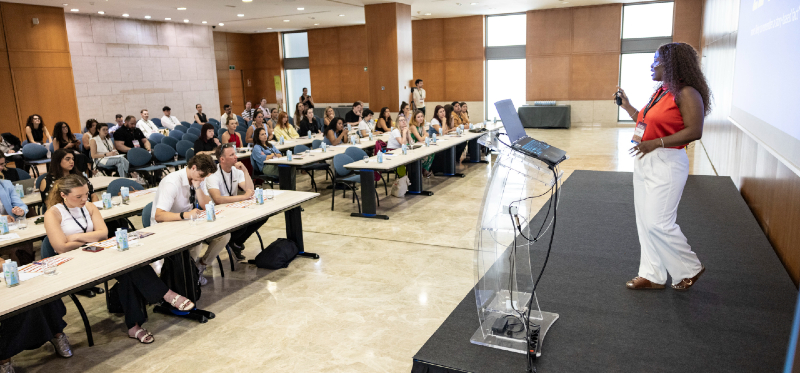
Introduction
As the world becomes increasingly interconnected, it is vital for businesses to adapt their marketing strategies to resonate with diverse consumer segments.
Let’s start by looking at why.
Multicultural marketing is vital today because consumers expect brands to reflect and respect their diverse identities and backgrounds. People want to see themselves represented in the products and ads they encounter, as this makes them feel valued and understood. This applies across all industries and all campaign types, both online and offline.
Multicultural marketing also provides a huge opportunity for brands themselves. Targeting diverse communities is a great way of expanding market reach by tapping into new customer bases. It is also a great way of building brand loyalty and fostering long-term relationships with a broader, more diverse range of loyal customers. And it allows brands to stay relevant in an ever-evolving marketplace.

The size of the opportunity
Let’s dig a little deeper into the size of the opportunity that multicultural marketing offers, by delving into the numbers:
- Demographic changes: Diversity is becoming more common all around the world. Looking at the US as an example, the US Census Bureau projects that by 2050, over half of the US population will be people of colour or Hispanic. Companies need diverse marketing strategies to resonate with a broader audience.
- Consumer preferences: Adobe found that 61% of respondents find diversity in advertising important. Consumers are more likely to support brands that reflect their own diversity.
- Brand loyalty (and brand abandonment): Accenture found that 41% of shoppers have shifted at least 10% of their business away from a retailer that does not reflect their views on diversity and inclusion. The risk of losing existing customers is definitely alarming for brands, as we all know it is much harder to gain a new customer than it is to retain an existing one.
- Customer satisfaction: McKinsey & Company found that brands that personalise their marketing efforts see 20% higher customer satisfaction rates.
- Sales: Kantar found that brands with ads that reflect diversity see 3.5% higher short-term sales and 16.5% higher longer-term sales, compared to non-diverse ads.
- Financial performance: McKinsey & Company found that companies in the top quartile for ethnic and cultural diversity in their executive teams are 36% more likely to have increased profitability, compared to the bottom quartile.
- Innovation: Boston Consulting Group found that companies with more diverse management teams have 19% higher revenue due to innovation. This is particularly relevant in marketing, where creativity and new ideas are crucial.
These stats demonstrate that as well as multicultural marketing being important from an inclusivity point of view, there is also a definite financial benefit for brands. Diverse communities are growing and they represent significant market potential. Tailoring your marketing to better represent all customers can therefore drive growth and enhance brand equity.
3 ways to tackle multicultural marketing
A one-size-fits-all approach to multicultural marketing is ineffective, since diverse communities have unique needs, preferences and values. A generic approach can therefore alienate potential customers. Success lies in understanding and addressing these specificities. Let’s look at three different approaches to multicultural marketing – from good, to better, to best in terms of effectiveness:
- Good: A good way of providing representation and cultural relevance is through translating your existing content into the language of the target community.
- Better: An even better approach is to adapt your existing content and imagery to ensure it is fully localised and provides local trust anchors, so that local audiences can really resonate with your messaging and your brand.
- Best: The best approach is to create your content from scratch specifically for the target community, tailored to their language and culture, as this will ensure your content is fully aligned with the target community’s needs.
Let’s look at an example of a campaign that went with this “best” approach of creating content from scratch for the target community.
In 2015, Coca-Cola delivered a culturally specific campaign for the Middle East, creating unique content specifically for the Ramadan season. It produced a video that featured scenes of iftar gatherings (breaking the fast) and emphasised themes of togetherness and sharing, which are significant during Ramadan. The idea was that all the lights were switched off, so that the people sharing the meal could not see who they were eating with, and so their perceptions of the other people were based solely on the content of their conversations and not any prejudices based on how they looked. Coca-Cola also removed labels from its product, saying “labels are for cans, not for people”.
The campaign successfully connected with Muslim consumers by respecting and celebrating their cultural practices, leading to increased brand loyalty and positive brand perception during the holy month. The video’s core message of tackling prejudice resonated well with the audience and had global reach, going well beyond this specific community.
Indeed, although the campaign was based around Ramadan and was specifically aimed at the Middle East, it truly resonated with people worldwide. This shows that creating content that seems to be very specific to one particular region can sometimes actually achieve global reach as well.
Detailed results of the campaign:
- The campaign earned Coca-Cola over USD 30 million in advertising and PR value, far exceeding the original target of USD 5 million.
- Over 25,000 articles reached hundreds of millions of people online in over 100 countries.
- The video triggered commentary on some of the world’s leading media platforms such as CNN, Time, Nasdaq, Mashable, Wired and Fast Company.
- The video had the most organic views for a brand video in the Middle East and North Africa region in 2015.
- It became the second-most viewed Coca-Cola online video of all time.
- Adweek ranked the video as being the second-most viral ad globally in 2015.
- It achieved an engagement rate of 35% on Facebook and 33% on X (formerly known as Twitter).
- Coca-Cola brand love increased 15% compared to the previous year.
- Coca-Cola consumption increased 51% compared to the previous year.
- Coca-Cola’s brand equity in bringing people closer together increased 39% compared to the previous year.
How to understand your target communities
There are certain steps you can take to understand your target communities, and this process can really help to inform your campaigns and messaging:
- Research: Conduct thorough market research. This will help you to understand audience expectations, trending topics, content gaps, and the activities of your competitors. There are various ways of conducting market research, including social listening and keyword research.
- Cultural insights: Gain deep insights into cultural nuances. Do user journey mapping and look to see if the user journey differs across different communities or even different generations within the same community. Make sure to include all the different online and offline touchpoints.
- Community engagement: Engage with community leaders and influencers. This will really enable you to reach your target community effectively.
- Feedback loops: Use customer feedback to constantly refine strategies and tweak tactics. This will help them stay relevant and effective.
You can really see the value of making the effort to understand your target communities when you look at real-life case studies. For example, if you are targeting the Hispanic community in the US, you might assume that you should just translate everything into Spanish – but making that assumption and taking a one-size-fits-all approach would be a mistake, because the real answer is more nuanced than that.
In case study 1, Webcertain supported a financial company in the US that wanted to reach its Hispanic audience. We identified through market research that the target audience did not necessarily use Spanish as their main dominant language – instead, they preferred to use a combination of English and Spanish, as they were fluent in both languages. This information allowed us to create content and messaging that really met the audience’s needs and preferences, with a real understanding of the audience forming the core of the project.
However, in case study 2, which involved a medical company targeting the Hispanic community in the US, the market research had completely different findings. In the medical realm, there was a Spanish-first preference within this group. The reason being that there is a much broader range of Hispanic individuals who may need access to medical services; multiple generations, some of whom may not be fluent in English or may simply have a strong preference for using Spanish. This information allowed us to ensure everything was translated into Spanish and localised appropriately for the Hispanic community.
These two case studies show that even within a seemingly homogenous community, such as Hispanics in the US, there are diverse segments with unique characteristics that require targeted approaches.
Key steps for launching a successful multicultural campaign
The following workflow outlines the five key steps for launching a successful multicultural campaign:
- Identify your target segments: Use data analytics to pinpoint specific communities.
- Craft tailored messages: Develop messages that resonate culturally and emotionally.
- Choose the right channels: Leverage the platforms most frequented by your target audience.
- Collaborate with influencers: Partner with influencers who have a strong connection with the community.
- Monitor and adjust: Continuously monitor and measure campaign performance and make necessary adjustments.
Case study: Targeting Arabic-speaking and Russian-speaking communities in the UK
Let’s look at an interesting case study from a medical company that wanted to target Arabic-speaking and Russian-speaking communities in the UK. The client wanted to target those particular communities because they presented a big opportunity in terms of demand levels, but the communities often lacked the fluency in English to be able to communicate comfortably about medical topics.
The client wanted to localise, adapt and create in-language content for those communities, to reach them effectively and to fill in some gaps within the user journey that it had identified.
It is important to say here that the client already had a medical facility in place that could accommodate the user in their language once that potential user became a customer. This is important because you want to avoid the situation where you attract a specific audience with content localised for their community, and then are unable to provide a service to them in their language, as this would be a difficult situation where you have essentially misled them and mismanaged expectations.
This client handled it really well because it had everything in place to facilitate that continuous support – what it needed help with was capturing the audience and making them aware of its brand and services.
- Objective: Increase awareness, build trust and drive conversions amongst the Arabic-speaking and Russian-speaking communities in the UK.
- Strategy: Cultural and language adaptation through social media, search engine marketing and email marketing.
- Tactics: Content strategy and execution, influencer collaborations and sponsored events (collaborating with local cultural events and festivals celebrated within these communities).
- Result: 192% increase in link clicks.
Conclusion
I hope this blog post has been a useful introduction to the topic of multicultural marketing. The benefits for brands of targeting diverse communities are numerous, but let’s remind ourselves of the main ones again:
- Increased brand awareness: Multicultural marketing lets you reach new audiences within diverse communities.
- Enhanced customer loyalty: Multicultural marketing helps you retain existing customers by building trust and loyalty.
- Greater market share: Multicultural marketing enables you to outperform competitors with targeted strategies.
- Positive brand image: Multicultural marketing promotes an inclusive and progressive brand identity.
If you want support with your multicultural marketing efforts, our team of international digital marketing specialists are here to help – just get in touch with us today and a member of our team will get back to you!
You can also watch a recording of a webinar that I presented on this topic, here.







